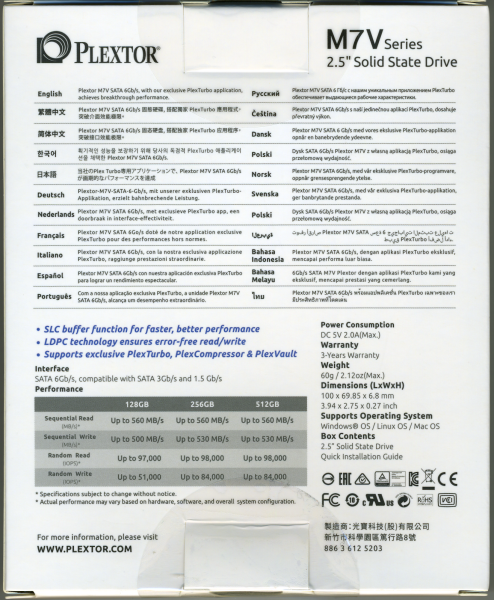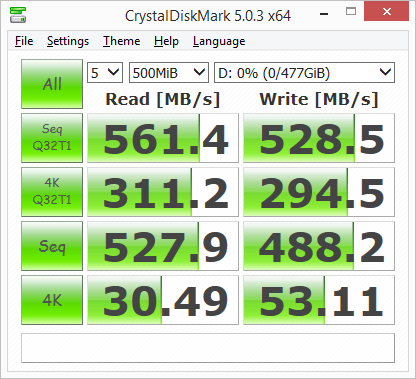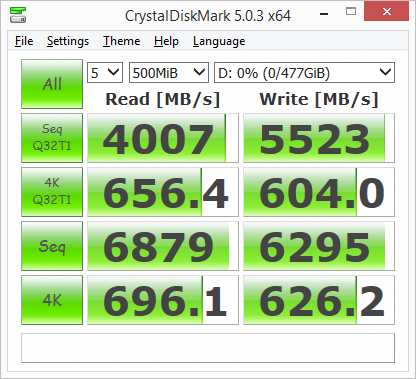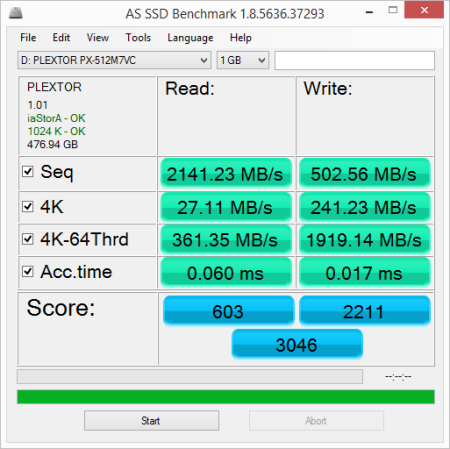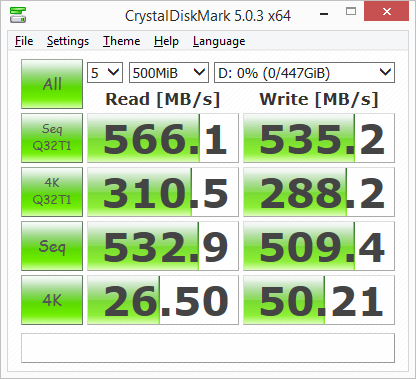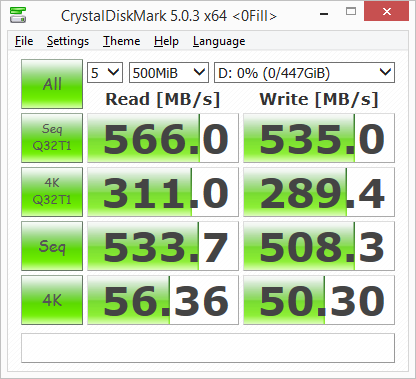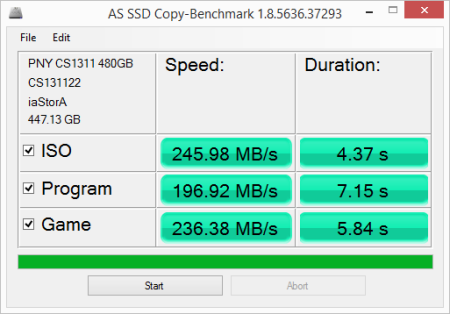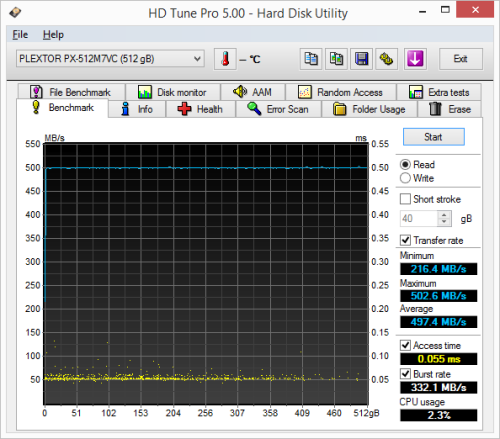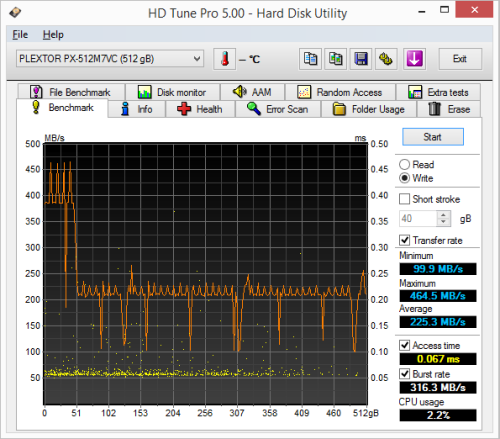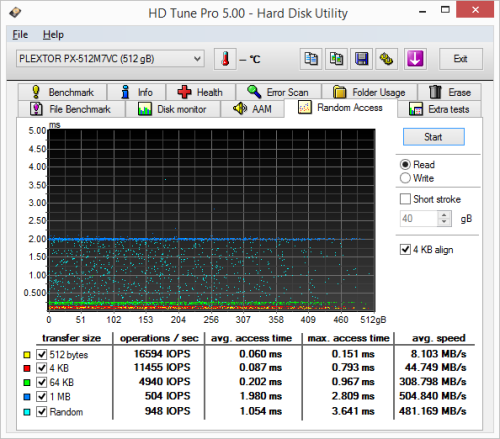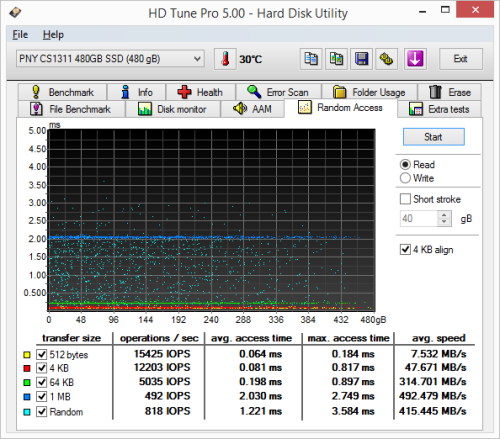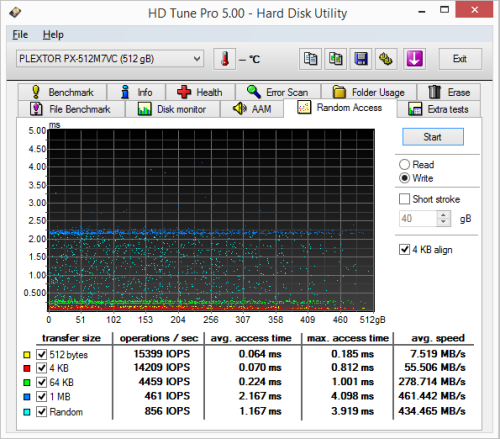

Model: Plextor M7V 512GB Solid State Drive
Manufacturer: Plextor
Provided By: Plextor LLC
As one of the biggest names in the storage industry, Plextor doesn't need much of an introduction. For more than a decade, they've produced some of the best optical drives the industry has seen. Known the world over for their quality, performance, and features, these drives have become favorites among consumers and professionals alike. Today, Plextor continues to lead the way by bringing cutting edge storage technologies to market. Along with an assortment of high-performance DVD and Blu-ray drives, the company offers a growing number of solid state drives.
 At this year's Consumer Electronics Show (CES), Plextor launched its first TLC NAND-based SSD, the M7V. Designed to meet the needs of cost-conscious consumers, this new entry-level SSD is powered by Marvell's 88SS1074B1 controller and is available with up to 512GB of Toshiba's 15nm TLC NAND flash. To compensate for the slow write speeds typically associated with TLC NAND, the M7V is equipped with Plextor's new PlexNitro cache acceleration technology, which optimizes performance without taking up any space on the drive. The M7V also has many of the same features found on Plextor's higher end SSDs. In addition to the company's PlexTurbo SSD RAM caching solution, the drive offers support for its PlexCompressor and PlexVault technologies.
At this year's Consumer Electronics Show (CES), Plextor launched its first TLC NAND-based SSD, the M7V. Designed to meet the needs of cost-conscious consumers, this new entry-level SSD is powered by Marvell's 88SS1074B1 controller and is available with up to 512GB of Toshiba's 15nm TLC NAND flash. To compensate for the slow write speeds typically associated with TLC NAND, the M7V is equipped with Plextor's new PlexNitro cache acceleration technology, which optimizes performance without taking up any space on the drive. The M7V also has many of the same features found on Plextor's higher end SSDs. In addition to the company's PlexTurbo SSD RAM caching solution, the drive offers support for its PlexCompressor and PlexVault technologies.
The M7V is available in 128GB, 256GB and 512GB capacities. For this review, Plextor sent us the 512GB version of the drive which is capable of delivering up to 560 MB/s sequential read and 535 MB/s sequential write speeds as well as up to 98,000 random read and 84,000 random write IOPS.
| Plextor M7V 512GB Solid State Drive | |||||||||||||||||||||||||||||||||||||||
General Specifications
Performance
Environment and Reliability
Dimensions and Weight
Other Features
|
Needless to say, this is only a taste of what the M7V has to offer. To give you an idea of what to expect, we'll take a closer look at Plextor's new SSD and then see how well it performs. Does the M7V have what it takes? More importantly, is it the best bang for your buck? Keep reading as we find out.
The M7V comes in an attractive blue, green and white box. The front advertises key features like the drive's 512GB capacity, SATA 6Gbps interface and support for Plextor's PlexTurbo, PlexCompressor and PlexVault technologies. The back of the box provides a bit more information regarding the M7V's features, specifications and box contents.

Plextor doesn't include a lot of extras with the M7V. Aside from the SSD, the only other thing in the box is a small, fold out guide containing warranty information as well as some brief installation instructions for both desktop and notebook computers in a number of different languages.
Physical Features:
Like Plextor's previous SSDs, the M7V is very well constructed. The drive's outer casing is made entirely out of metal. Along with it being strong and durable, it is very lightweight. On top of that, its brushed aluminum finish looks great.

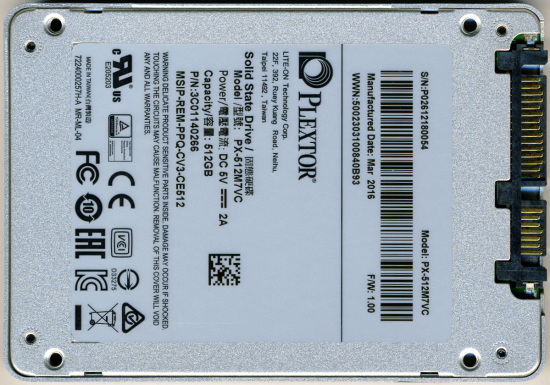
As I mentioned earlier, the M7V uses Marvell's 88SS1074B1 controller. Manufactured using an advanced 28nm CMOS process, the controller features support for 15nm TLC/MLC/SLC and 3D NAND. The 88SS1074B1 also offers low power support with integrated DEVSLP (Device Sleep) as well as Marvell’s third generation NANDEdge error-correcting, low-density parity check (LDPC) technology for superior endurance and reliability.

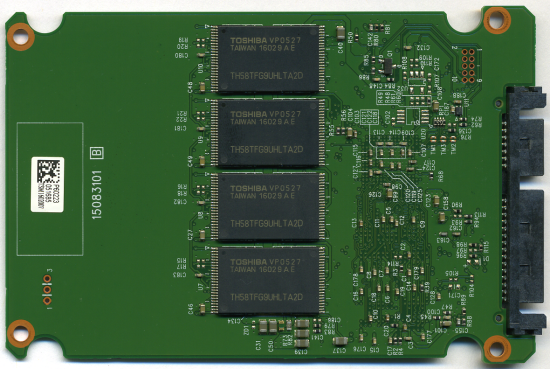
For the 512GB version of the M7V, Plextor has opted to use Toshiba's 15nm Toggle Mode TLC NAND flash. Looking at the pictures above, you can see that there are four 64GB NAND flash packages on either side of the PCB. The drive also has 512MB and 256MB NANYA DDR3L memory chips that are used for caching.
Like Plextor's other, higher end drives, the new M7V works with their Plextool software. Designed exclusively for Plextor SSDs, this free downloadable tool lets users check the status of their drive. From the main screen, users can view information like the overall health, total capacity, free space and firmware version of each drive.
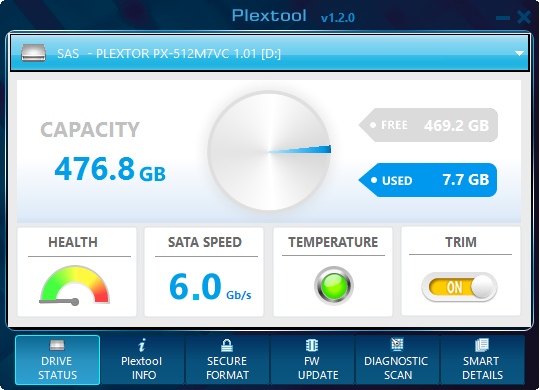
The Secure Format feature gives users the option to delete all the data on an SSD in a way that it can never be recovered, restoring the drive to its original performance.
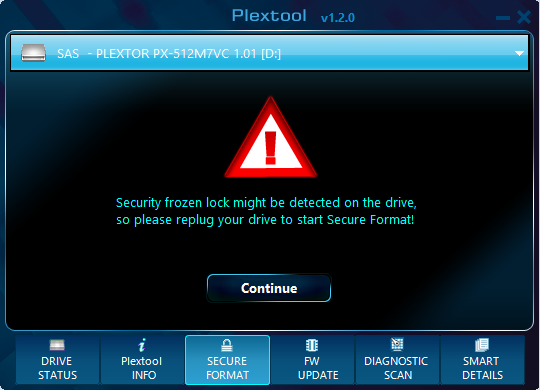
Plextool also gives users the ability to update a drive's firmware, perform a diagnostic scan and check its S.M.A.R.T. details and see if there are any issues.
PlexCompressor
The M7V also supports Plextor's PlexCompressor technology. Available as a free download, PlexCompressor is a smart compression program that compresses files left unused for an extended period of time in order to save space.

During each compression, only part of the space is compressed, avoiding occupation of system resources for long periods of time. After an extended period of use, most of the rarely used files are in a compressed state, and commonly used files are in a decompressed state. Compression of new files gradually decreases, until eventually almost no system resources are devoted to compression.

PlexCompressor can be monitored through its Viewer utility. From here, you can see which disks PlexCompressor is enabled on as well as the compression rate and the amount of increased free space.
PlexVault
Plextor's PlexVault software is aimed to provide a secure space where users can store personal information. Using the software, users can set up hidden disk spaces which can be opened or closed using a set of hotkeys. A password can also be set for even greater security.
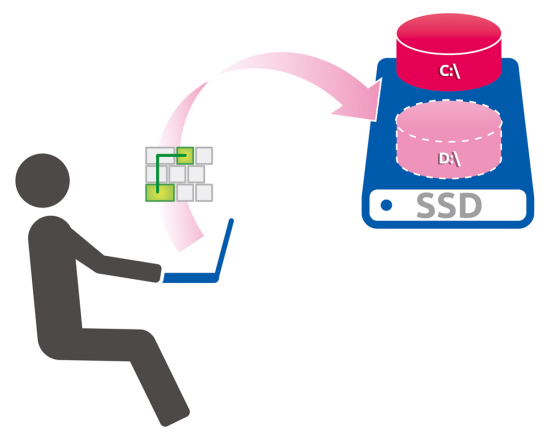
When opened, the PlexVault volume will appear as an additional drive letter on your computer. Otherwise it remains hidden and cannot be found through the Device Manager or the Disk Administrator.
PlexTurbo
Last but not least, you have Plextor's PlexTurbo technology. This smart caching software uses system RAM to prolong the life of the drive and push its performance beyond the bandwidth limitations of the SATA interface.
Once installed, you can monitor PlexTurbo using the Viewer. This utility runs in the system tray, showing which disks Plextool is enabled on as well as the current cache capacity and the total reduced write volume. The reduced write volume is proportional to the extension of the drive's lifespan.
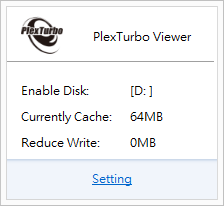
With the latest version of PlexTurbo, you can set the maximum cache size and the cache release time. You can also have it preload data files that were used immediately prior to the last shutdown and automatically run the Viewer after start up.
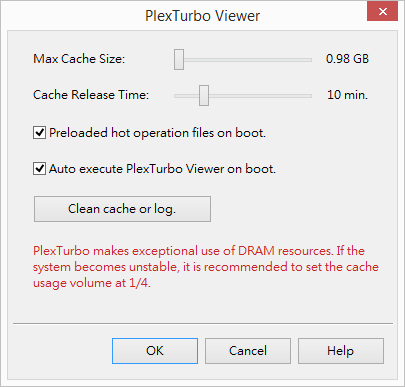
By default, PlexTurbo uses anywhere from 1/4 to 1/2 of your system memory. With the M6 Pro and M6e, the maximum amount of memory it can use is 16GB. However, with the M7V, this number is capped at 1GB. Even with this limitation, we saw some considerable gains in our tests. When tested with CrystalDiskMark, ATTO and AS SSD, sequential read and write speeds increased, in some cases, by more than 7x.
The test system used in this review was an HP 8200 Elite. The computer came equipped with an Intel Core i5-2400 CPU, 4GB of DDR3 1333MHz memory, Seagate Barracuda 7200.12 ST3250312AS 250GB SATA 6 Gb/s hard drive, NVIDIA Quadro FX580 512MB PCIe graphics card and an Intel 82579-LM gigabit network card. For the operating system, I installed a fresh copy of Windows 8.1 Enterprise.
To test the performance of Plextor's M7V SSD, I ran a series of benchmarks using CrystalDiskMark 5.0.3, HD Tach RW 3.0.4.0, ATTO Disk Benchmark 2.46, AS SSD, HD Tune Pro 5.00, Anvil's Storage Utilities, Iometer and PCMark 8. For comparison, I've also included test results from the PNY CS1311, OCZ Trion 150, PNY CS2211, Plextor M6V, Crucial BX200, OCZ Trion 100, Kingston HyperX Savage, Crucial MX200, OCZ Vector 180, Kingston BX100, Samsung 850 EVO M.2, Samsung 850 EVO mSATA, AMD Radeon R7, Silicon Power Slim S80, Samsung SSD 850 EVO, OCZ ARC 100, SanDisk Ultra II, Kingston MX100, SanDisk Extreme Pro, Samsung SSD 850 PRO, Plextor PX-256M6S and Toshiba Q Series Pro.
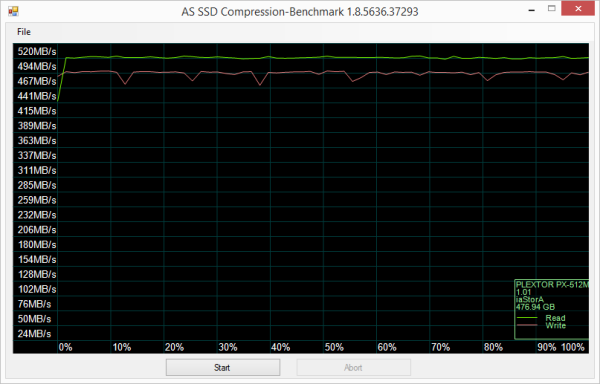
As I mentioned earlier, the PNY is based on Marvell's 88SS1074B1controller chip. Looking at the screenshot above, you can see that it performs equally well with both incompressible (0%) and compressible (100%) data.
CrystalDiskMark 5.0.3:
First, I ran a few quick tests using CrystalDiskMark. This benchmark tool measures the performance of a storage device by testing its sequential read and write speeds as well as its random read and write speeds using blocks 512K and 4K in size.
According to Plextor, the 512GB M7V is capable of reading at 560 MB/s and writing at 530 MB/s when connected to a SATA 6 Gb/s port. While the drive performed better than expected when reading, it came up a bit short in CrystalDiskMark's sequential write speed test.
The M7V performed equally well when using highly compressible 0x00 (0 Fill) data. This time around, the drive was able to read at 561 MB/s and write at 529.2 MB/s.
HD Tach RW 3.0.4.0:
Next, I used HD Tach to test the M7V's read, write and burst speeds as well as its seek times and CPU usage.
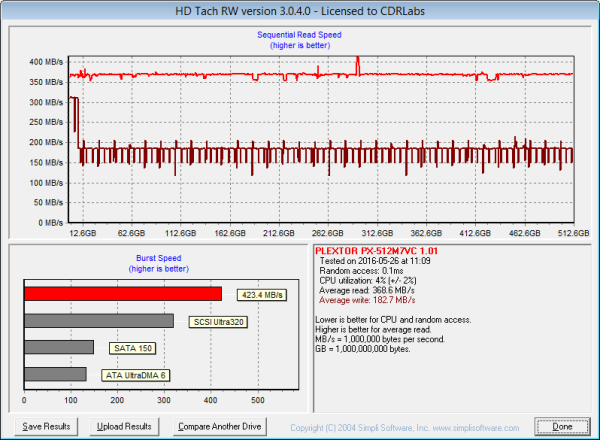
Looking at the screenshot above, you can see that the M7V had average read and write speeds of 368.6 MB/s and 182.7 MB/s respectively, as well as a burst speed of 423.4 MB/s. The screenshot also shows that, like most other TLC-based SSDs, the M7V uses some sort of SLC caching. The drive starts writing at about 310 MB/s and then drops to about 190 MB/s when the write operation exceeds the size of the cache.
ATTO Disk Benchmark 2.46:
I also used ATTO Disk Benchmark to test the M7V's sequential read and write speeds. The tests are run using blocks ranging in size from 0.5KB to 8192KB and the total length set to 256MB.
When tested with ATTO, the M7V's read speeds topped out at about 564 MB/s and its write speeds at 536 MB/s.
AS SSD:
AS SSD is a relatively new benchmark designed specifically for solid state drives. The application contains five synthetic tests used to determine the sequential and random read and write performance of a drive.
AS SSD also includes a copy benchmark. This test copies an ISO (two large files), program (many small files) and game (small and large files), returning the speed and duration of each.
HD Tune Pro 5.00:
Next, I ran a series of tests using HD Tune Pro. This hard disk utility measures a drive's performance by testing its sequential read and write speeds as well as its access time, burst rate and CPU usage. For this review, I'm also going to use it to benchmark the M7V's random read and write speeds, random access times and the number of operations per second.
The M7V performed relatively well when benchmarked with HD Tune. The drive had average read and write speeds of 497.4 MB/s and 225.3 MB/s, respectively, and a burst rate of 332.1 MB/s when reading.
When reading 4KB blocks, the M7V reached 11,455 IOPS and had an average speed of 44.749 MB/s. The drive was even faster when writing, reaching 14,209 IOPS with an average speed of 55.506 MB/s.
Anvil's Storage Utilities:
Anvil's Storage Utilities is another new benchmark designed with SSDs in mind. The standard storage benchmark measures a drive's performance by testing its transfer speeds, access times and IOPS.

Iometer:
Lastly, I ran a series of tests using Iometer. This tool can be configured to benchmark a number of things. In this case, I used it to measure the M7V's read and write speeds and the number of operations per second. The tests were run using random bytes and a queue depth of 3.
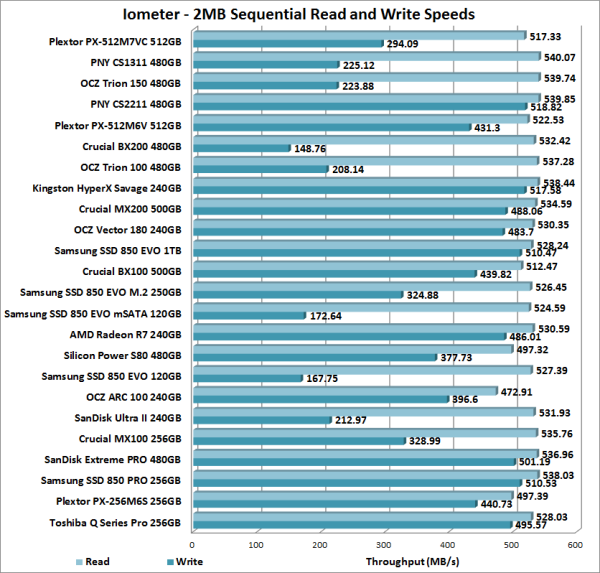
The M7V's performance was hit and miss when tested with Iometer. While the drive was able to read at a respectable 517.33 MB/s, its sequential write speed averaged out at only 294.09 MB/s.
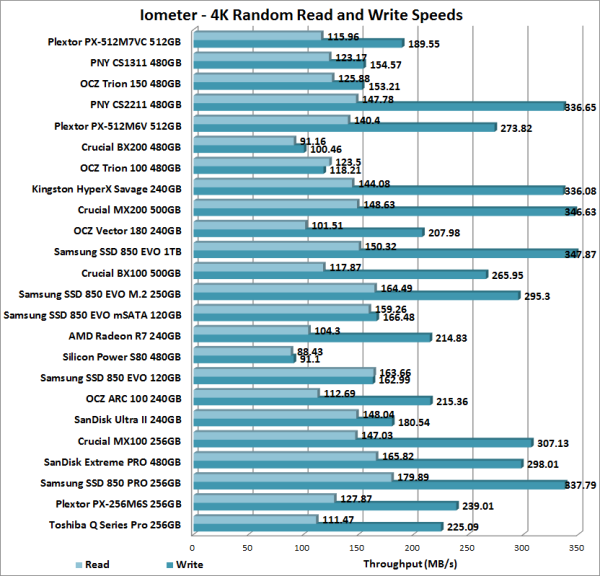
The M7V wasn't one of the faster drives we've tested when it came to random reads and writes. In our tests, the drive was able to read at 115.96 MB/s and write at 189.55 MB/s.
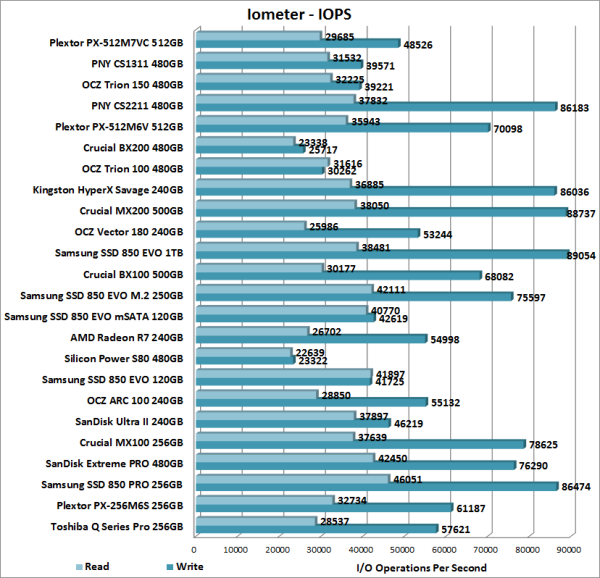
According to Plextor, the 512GB M7V is capable of 98,000 IOPS when reading and 84,000 IOPS when writing 4K blocks. In our tests, the drive reached 29,685 random read IOPS and 48,526 random write IOPS. As with most drives, the M7V performed better at higher queue depths. With the queue depth set to 32, it reached 89,059 random read IOPS and 64,084 random write IOPS.
Vantage PCMark 8 - Storage Test:
PCMark 8 is a complete benchmark for Windows. It includes five benchmark tests, each designed around a specific scenario. The storage benchmark measures drive performance using real-world traces recorded from Adobe Creative Suite, Microsoft Office and a selection of popular games.
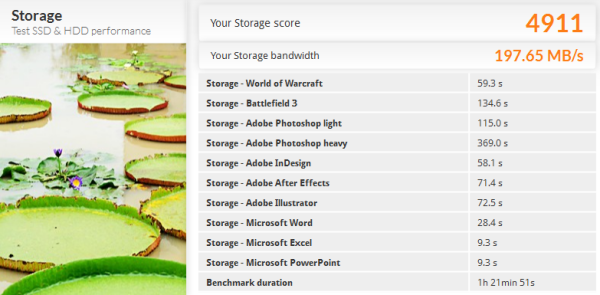
PCMark 8 also includes a consistency test which measures the performance consistency and degradation tendency of a storage system. The test reports the performance level at the start, the degraded steady-state and the recovered state as well as the number of iterations required to reach them. For this test, we are focusing on the Adobe Photoshop (Heavy) trace and will look at both the bandwidth and latency of the drive
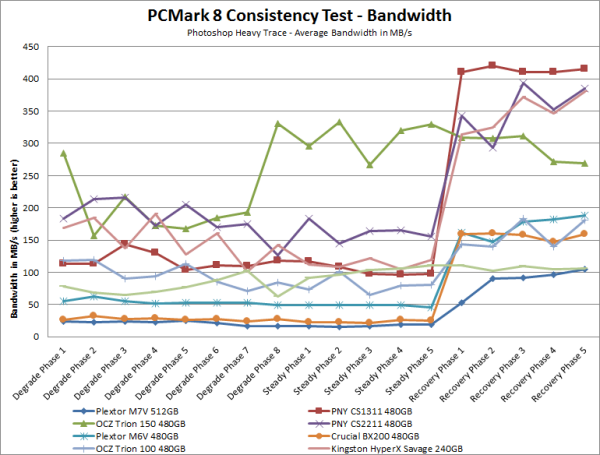
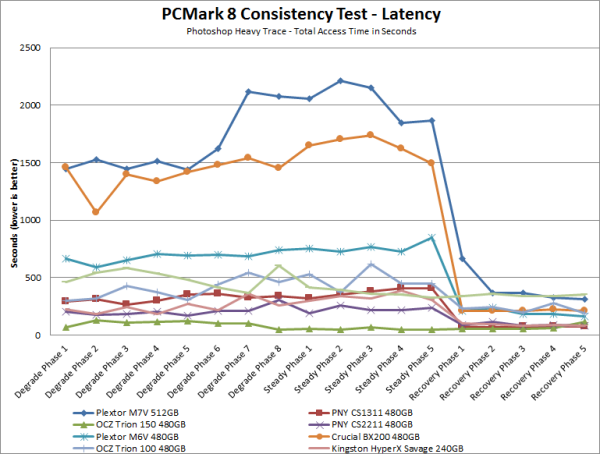
The M7V didn't do as well as some of the other drives in this test. Its bandwidth dropped below 25 MB/s during the degradation and steady phases, pushing its latency above the 2000ms mark. The M7V's performance increased somewhat during the recovery phase. However, it came up short of the other drives, topping out at a mere 104 MB/s.
TRIM Performance:
While SSD's offer many benefits, there are some downsides to using flash memory. One of the biggest issues people run into is performance degradation. Over time, an SSD will run out of fresh blocks and will have to write over data the file system has marked as deleted. This procedure is very complicated and can slow an SSD's write speeds considerably.
To fix this problem, most manufacturers have added TRIM support to their SSDs. The TRIM command allows an operating system, such as Windows 7, to tell an SSD which data blocks are no longer in use. Using this information, the drive pro-actively erases these blocks and adds them to the free block pool.

To test the M7V's TRIM and garbage collection functions, I first put the drive in a "dirty" state. I used Iometer to fill the entire drive and then ran a random write test for 30 minutes. This had little impact on the M7V's read speed. However, its average writing speed dropped to a mere 43.3 MB/s.

Plextor M7V - Dirty
To see how well the M7V could recover, I let the computer sit for about 30 minutes and then reran the test. The drive wasn't able to reach the factory fresh performance shown in our earlier tests. However, its average write speed climbed up to 243.9 MB/s.

Plextor M7V - After TRIM
Lastly, I used Plextor's Plextool software to perform a secure format on the M7V. With the drive wiped clean, it had average read and write speeds of 368.7 MB/s and 258.4 MB/s, respectively.

Plextor M7V - Secure Erased
Final Thoughts:
Plextor has clearly put a lot of time and effort into the M7V. To make it stand out in an already crowded market, the M7V utilizes high-grade components like Marvell's 88SS1074B1 controller and Toshiba's 15nm TLC NAND flash. The M7V also comes equipped with the company's exclusive PlexNitro firmware which optimizes performance in SLC mode without taking up any space on the SSD. This combination not only provides fast and reliable performance, it gives the drive a durability that is higher than most other TLC SSDs. In our sequential read and write tests, the 512GB version of the M7V was able to read at speeds as high as 564 MB/s and write at speeds in excess of 528 MB/s. It also did reasonably well in our random write tests, producing more than 48,000 IOPS at low queue depths.
Fast read and write speeds aren't the only things the M7V has to offer. The drive is compatible with Plextor's Plextool software and supports their PlexTurbo smart cache technology. The M7V is also compatible with PlexVault and PlexCompressor software, which, until now, have been reserved for the company's higher end drives. That being said, the M7V does not support Device Sleep (DEVSLP) or hardware based encryption. This probably isn't an issue if you're looking for an SSD for your desktop computer. However, these are things you may want to keep in mind if the M7V is going in a laptop or data security is a concern.
The M7V is available now in 128GB, 256GB and 512GB capacities. Prices on Amazon.com currently range from $59 up to $130 for the 512GB version reviewed here.

Highs:
- Available in 128GB, 256GB and 512GB capacities
- Marvell 88SS1074B1 controller with LDPC technology
- Toshiba 15nm TLC NAND flash
- Good sequential read and write speeds under most conditions
- PlexNitro firmware optimizes performance without taking up SSD space
- Supports PlexTurbo, PlexVault and PlexCompressor technologies
- Large DRAM cache
- Ultra-slim form factor
- 3 year warranty
- Affordably priced
Lows:
- Write speed drops when PlexNitro cache is full
- Does not support DEVSLP
- Does not support hardware based encryption

